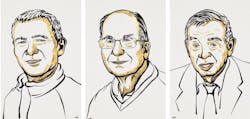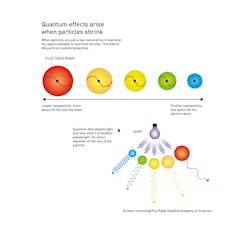2023 Nobel Prize in Chemistry recognizes discovery of quantum dots
The three newest Nobel Laureates in Chemistry are: Moungi G. Bawendi, who leads the Bawendi Group within the chemistry department at Massachusetts Institute of Technology, Louis E. Brus, a professor of chemistry at Columbia University, and Alexei I. Ekimov, chief scientist at Nanocrystals Technology Inc. in New York (see video).
The 2023 Nobel Prize in Chemistry rewards the discovery and development of quantum dots—nanoparticles so incredibly tiny that their properties are determined by quantum phenomena. These smallest components of nanotechnology now spread their light from televisions and LED lamps, and can even guide surgeons when they remove tumor tissue, among other things.
“Quantum dots have many fascinating and unusual properties,” says Johan Äqvist, chair of the Nobel Committee for Chemistry.
Physicists had long known that, in theory, size-dependent quantum effects could arise in nanoparticles, but at the time it was almost impossible to sculpt in nanodimensions—and few people believed this knowledge would be put to practical use.
But in the early 1980s, Alexei Ekimov created size-dependent quantum effects in colored glass. The color came from nanoparticles of copper chloride and he demonstrated that particle size affected the color of the glass via quantum effects.
A few years later, Louis Brus proved size-dependent quantum effects in particles floating freely within a fluid.
In 1993, Moungi Bawendi revolutionized the chemical production of quantum dots, which resulted in almost-perfect particles. This high quality was necessary to enable their use in applications.
Today, quantum dots illuminate computer monitors and TV screens based on QLED technology. They also add nuance to the light of some LED lamps, and biochemists and doctors use them to map biological tissues.
In the future, quantum dots may contribute to flexible electronics, tiny sensors, thinner solar panels, and encrypted quantum communications—so we’ve just begun to explore the potential of these tiny particles.

